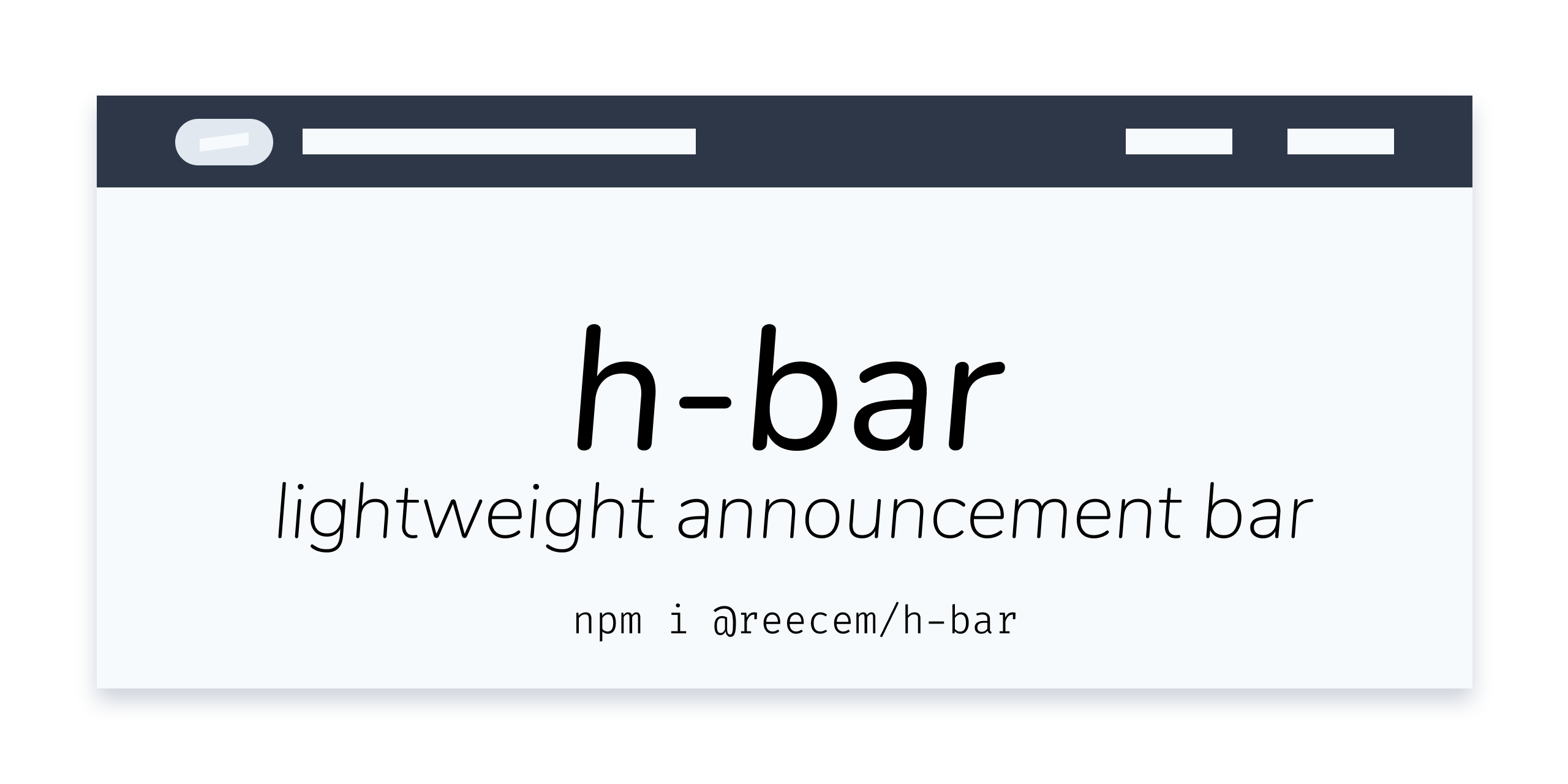h-bar lightweight announcement bar
An Announcement Banner that is lightweight and based on tailwindcss for the styling




h-bar Announcement banner
The announcement bar uses native methods to make the library lightweight so that it can be loaded quickly, bar the webpack stuff.
Note
The initial version makes use of the WordPress API to be able to get the latest post.
i.e. it expects a json structure like so:
From a url like http://blog.example.com/wp-json/wp/v2/posts?per_page=1&_fields=id,title,link
[
{
"id": 175,
"link": "https:\/\/blog.example.com\/how-to-hunt-a-vole\/",
"title": {
"rendered": "How To Hunt A Vole"
}
}
]
I plan to add more options and a parser callback that can be defined to extract a standard format.
Installation
You can install the package via npm:
npm i @reecem/h-bar
Or use jsDelivr:
...
<script src"https://cdn.jsdelivr.net/npm/@reecem/h-bar@latest/dist/hBar.min.js"></script>
...
If you are customising the styling and overriding it with your own styling then you will also need an instance of your css or a tailwindcss file installed as only the classes needed are packaged with h-bar
Usage
You can import it directly into your javascript app or use it in the html.
<script src="../hBar.js"></script>
<script src"https://cdn.jsdelivr.net/npm/@reecem/h-bar@latest/dist/hBar.min.js" defer></script>
<script>
hBar.init({
url: "http://blog.example.com/wp-json/wp/v2/posts?per_page=1&_fields=id,excerpt,title,link",
secondaryLinks: [
{
title: "Docs",
link: "http:://docs.example.com"
},
{
title: "Support",
link: "http://help.example.com"
}
],
options: {
theme: "blue",
}
});
hBar.fetchData()
</script>
The initialization object currently has this structure and defaults:
{
url: "https://your.blog/api/....",
onCompleted: "callback function",
postLink: "The link url, can be force and no need to fetch from API",
postTitle: "The link url, can be force and no need to fetch from API",
secondaryLinks: [
{
title: "Docs",
link: "http:://docs.example.com"
}
],
parser: (data) => {}
options: {
theme: "gray",
secondaryLinks: [],
onCompleted: null,
fetchOptions: {
"method": "GET",
"mode": "cors",
"cache": "no-cache",
"headers": {
"Accept": "application/json"
},
"redirect": "follow"
}
},
customStyles: {
wrapper: "hb-flex hb-w-full hd-flex-col md:hb-flex-row sm:hb-flex-row hb-text-sm hb-py-2 md:hb-px-20 hb-px-1 hb-items-center hb-justify-between",
linkWrapper: "hb-flex hb-items-center",
badge: "hb-px-2 hb-mx-2 hb-leading-relaxed hb-tracking-wider hb-uppercase hb-font-semibold hb-rounded-full hb-text-xs",
postTitle: "hover:hb-underline",
secondaryLink: "hb-mx-5 hb-cursor-pointer hover:hb-underline",
}
}
Parser function
There is the availability of adding a custom parser function to override any of the default ones provided by the package.
This is handy if you have a custom endpoint that say would return also the secondary links or has a different data structure.
The parser function should always return an object with the structure:
{
title: String,
link: String,
secondaryLinks: [
{
title: String,
link: String,
},
]
}
You can define the function inside the init() method as follows:
hBar.init({
url: "https://api.github.com/repos/ReeceM/h-bar/releases",
parser: (data) => {
const {name, html_url} = data[0];
return {
title: `Lateset version available ${name}`,
link: html_url
};
}
})
Testing
to come please make a PR if you know how to do it on JS.
Changelog
Please see CHANGELOG for more information on what has changed recently.
Contributing
Please see CONTRIBUTING for details.
Security
If you discover any security related issues, please email zsh.rce@gmail.com instead of using the issue tracker.
Credits
Support


License
The MIT License (MIT). Please see License File for more information.










